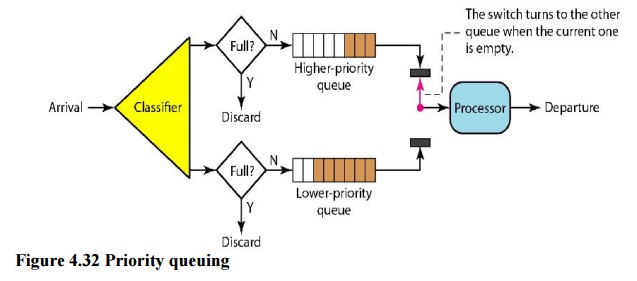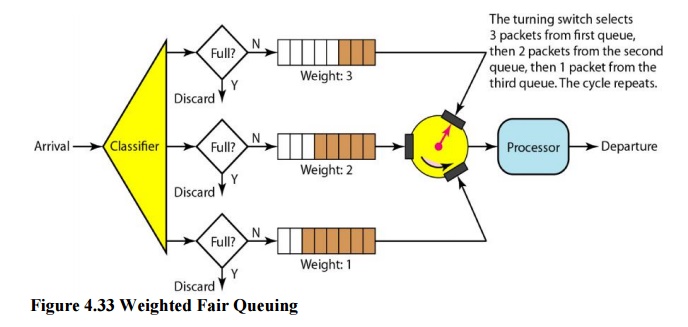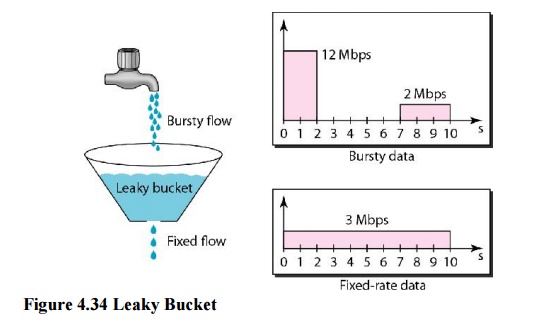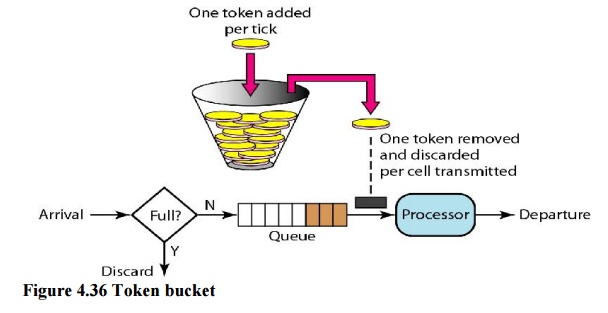Chapter: Computer Networks : Transport Layer
Techniques to Improve QoS
Techniques to Improve QoS
Some
techniques that can be used to improve the quality of service. The four common
methods: scheduling, traffic shaping, admission control, and resource
reservation.
a. Scheduling
Packets
from different flows arrive at a switch or router for processing. A good
scheduling technique treats the different flows in a fair and appropriate
manner. Several scheduling techniques are designed to improve the quality of
service. We discuss three of them here: FIFO queuing, priority queuing, and
weighted fair queuing.
i. FIFO Queuing
In
first-in, first-out (FIFO) queuing, packets wait in a buffer (queue) until the
node (router or switch) is ready to process them. If the average arrival rate
is higher than the average processing rate, the queue will fill up and new
packets will be discarded. A FIFO queue is familiar to those who have had to
wait for a bus at a bus stop.

ii. Priority Queuing
In
priority queuing, packets are first assigned to a priority class. Each priority
class has its own queue. The packets in the highest-priority queue are
processed first. Packets in the lowest- priority queue are processed last. Note
that the system does not stop serving a queue until it is empty. Figure 4.32
shows priority queuing with two priority levels (for simplicity).
A
priority queue can provide better QoS than the FIFO queue because higher
priority traffic, such as multimedia, can reach the destination with less
delay. However, there is a potential drawback. If there is a continuous flow in
a high-priority queue, the packets in the lower-priority queues will never have
a chance to be processed. This is a condition called starvation

iii. Weighted Fair Queuing
A better
scheduling method is weighted fair queuing. In this technique, the packets are
still assigned to different classes and admitted to different queues. The
queues, however, are weighted based on the priority of the queues; higher
priority means a higher weight. The system processes packets in each queue in a
round-robin fashion with the number of packets selected from each queue based
on the corresponding weight. For example, if the weights are 3, 2, and 1, three
packets are processed from the first queue, two from the second queue, and one
from the third queue. If the system does not impose priority on the classes,
all weights can be equal. In this way, we have fair queuing with priority.
Figure 4.33 shows the technique with three classes.

b. Traffic Shaping
Traffic
shaping is a mechanism to control the amount and the rate of the traffic sent
to the network. Two techniques can shape traffic: leaky bucket and token bucket
i. Leaky Bucket
If a
bucket has a small hole at the bottom, the water leaks from the bucket at a
constant rate as long as there is water in the bucket. The rate at which the
water leaks does not depend on the rate at which the water is input to the
bucket unless the bucket is empty. The input rate can vary, but the output rate
remains constant. Similarly, in networking, a technique called leaky bucket can
smooth out bursty traffic. Bursty chunks are stored in the bucket and sent out
at an average rate. Figure 4.34 shows a leaky bucket and its effects.

In the
figure, we assume that the network has committed a bandwidth of 3 Mbps for a
host. The use of the leaky bucket shapes the input traffic to make it conform
to this commitment. In Figure 4.34 the host sends a burst of data at a rate of
12 Mbps for 2 s, for a total of 24 Mbits of data. The host is silent for 5 s
and then sends data at a rate of 2 Mbps for 3 s, for a total of 6 Mbits of
data. In all, the host has sent 30 Mbits of data in lOs. The leaky bucket
smooth’s the traffic by sending out data at a rate of 3 Mbps during the same 10
s.

A simple
leaky bucket implementation is shown in Figure 4.35. A FIFO queue holds the
packets. If the traffic consists of fixed-size packets (e.g., cells in ATM
networks), the process removes a fixed number of packets from the queue at each
tick of the clock. If the traffic consists of variable-length packets, the
fixed output rate must be based on the number of bytes or bits.
The
following is an algorithm for variable-length packets:
·
Initialize a counter to n at the tick of the clock.
·
If n is greater than the size of the packet, send
the packet and decrement the counter by the packet size. Repeat this step until
n is smaller than the packet size.
·
Reset the counter and go to step 1.
A leaky bucket algorithm shapes bursty traffic into
fixed-rate traffic by averaging the data rate. It may drop the packets if the
bucket is full.
ii. Token Bucket
The leaky
bucket is very restrictive. It does not credit an idle host. For example, if a
host is not sending for a while, its bucket becomes empty. Now if the host has
bursty data, the leaky bucket allows only an average rate. The time when the
host was idle is not taken into account. On the other hand, the token bucket
algorithm allows idle hosts to accumulate credit for the future in the form of
tokens. For each tick of the clock, the system sends n tokens to the bucket.
The system removes one token for every cell (or byte) of data sent. For
example, if n is 100 and the host is idle for 100 ticks, the bucket collects
10,000 tokens.

The token
bucket can easily be implemented with a counter. The token is initialized to
zero. Each time a token is added, the counter is incremented by 1. Each time a
unit of data is sent, the counter is decremented by 1. When the counter is
zero, the host cannot send data.
The token bucket allows bursty traffic at a
regulated maximum rate.
Combining
Token Bucket and Leaky Bucket
The two
techniques can be combined to credit an idle host and at the same time regulate
the traffic. The leaky bucket is applied after the token bucket; the rate of
the leaky bucket needs to be higher than the rate of tokens dropped in the
bucket.
c. Resource Reservation
A flow of
data needs resources such as a buffer, bandwidth, CPU time, and so on. The
quality of service is improved if these resources are reserved beforehand. We
discuss in this section one QoS model called Integrated Services, which depends
heavily on resource reservation to improve the quality of service.
d. Admission Control
Admission
control refers to the mechanism used by a router, or a switch, to accept or
reject a flow based on predefined parameters called flow specifications. Before
a router accepts a flow for processing, it checks the flow specifications to
see if its capacity (in terms of bandwidth, buffer size, CPU speed, etc.) and
its previous commitments to other flows can handle the new flow.
Related Topics